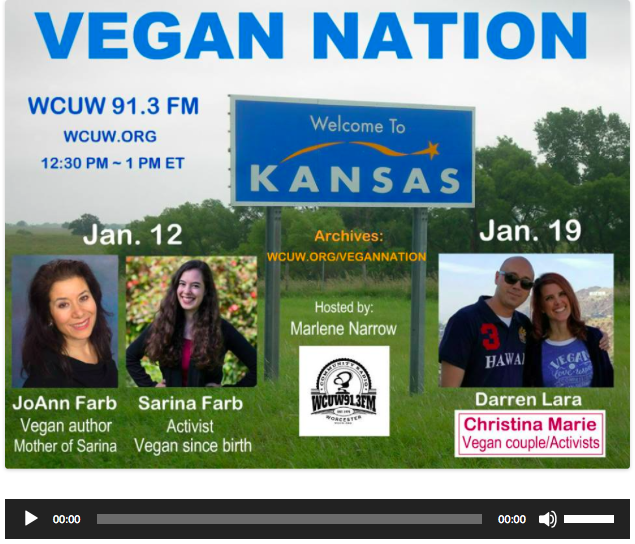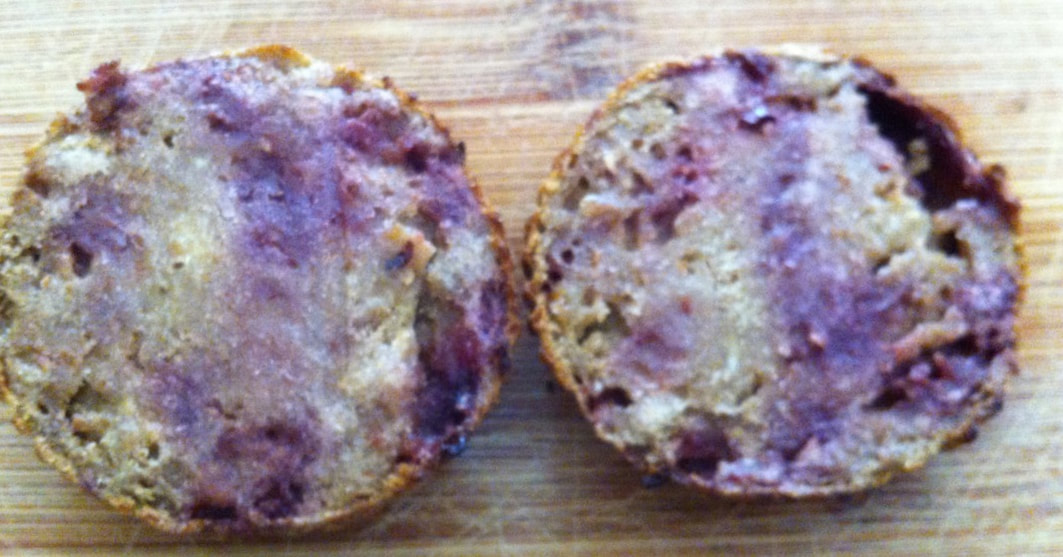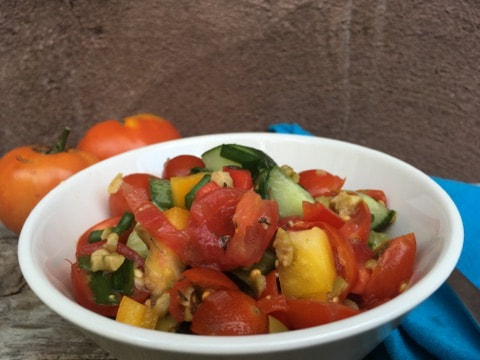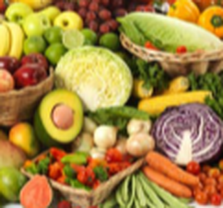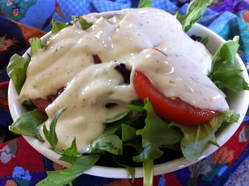
 Although it uses a lot of ingredients, this dressing is simple and quick to make. It is very low in fat and full of flavor, with just half a gram of fat (from the tofu) per two tablespoons. Just place all the ingredients in a blender and blend on high until rich and creamy. Store unused portion in a jar in the refrigerator for up to 4-5 days. It's a great dip for vegetable slices as well. This makes about two and half cups.
0 Comments
Last night was the first meeting of the new, Plant-Based Paleo Support Group and one of the recipes that I demonstrated and then served was this Heart-Beet Salad with Goddess Dressing. This recipe was originally published in my book, Get Off Gluten. The Goddess dressing is made entirely without oil or sugar, and the combination of Goddess Dressing with cooked beets is amazing! 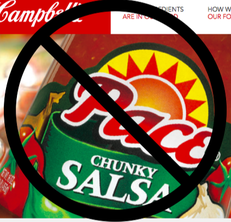 Earlier this evening, my husband and I sat down to a common dinner that we love -- home made black bean burritos topped off with Pace Salsa. For the past ten years, my family's consumption of Pace Salsa surely made us one of Campbell's better customers. Not just because of how much we eat, but because of all the demos I do, and food I make for others. I would purchase salsa in the largest size glass containers sold, sometimes bringing home a dozen jars at a time -- just to make sure I didn't run out. But that is in the past. I won't be buying Pace products any more. What, you may be wondering could have caused a passionate salsa lover like me, always looking for the best food bargains too (Pace is often the least expensive salsa I can find) to stop eating the stuff (right in the middle of dinner) and vow to not eat it any more? Well it was this. I was
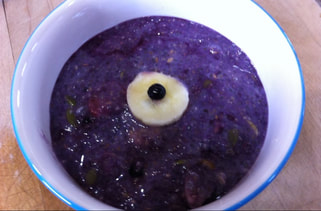 I love this for its simplicity and that I can have a delicious and satisfying breakfast in about five minutes time. You can use any non-dairy milk in this recipe. I like to make my own, however, for this recipe, you can even use a much simpler home made milk -- simply take 1 TBS of sunflower seeds (or cashews or almonds) and blend them in a blender with 1/2 cup of water -- no need to filter as the added fiber works well in this dish. If you'd rather purchase milk and are curious to know what to look for on the label, I discuss all that HERE. If you are using a store bought milk that is already sweetened and or flavored, you can OMIT the stevia extract and or vanilla. If you don't have stevia, a bit of maple syrup or a 2 finely chopped dates would work too. Also -- you can use any combination of fresh, frozen or dried fruit in this as well -- below is the combination and amounts I typically use. While this does make a terrific breakfast, it can also be a perfect afternoon snack or pick-me-up too. This is one of the most basic recipe building blocks that I use in the kitchen. It is super simple, and can be made from mostly non-perishable pantry staples. It replaces store-bought sour creams -- which are often not only quite pricey, but contain added oils, high sodium and or other undesirable ingredients. Make sure that the tofu is organic and Non-GMO project verified, as soy products have a high likelihood of being genetically modified and/or contaminated with Round-Up or other chemicals. Silken tofu gives the best result, but you could use another tofu in a pinch. I always buy the firmest tofu I can find -- the difference between soft and firm is simply how much water has been squeezed out. No point paying for extra water.
Ingredients: 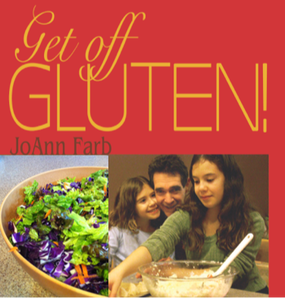 It’s no secret that gluten-free foods are one of the fastest growing sectors in the food industry. Yet many mainstream health and nutrition sources still discourage adoption of a gluten free diet for anyone without a laboratory confirmed diagnosis of Celiac Disease (CD). Some widely touted studies have suggested that “gluten sensitivity” may not exist, and suggest that FODMAPS, not gluten are causing the GI symptoms that people assumed were from gluten. There are other studies that suggest many who are harmed from gluten have no obvious GI symptoms and may be negative for CD by every known test. Sometimes they present only with anemia, or osteoporosis which many doctors still don't know can be caused from consuming gluten. Every currently used medical test to identify those who might be harmed by gluten, has many 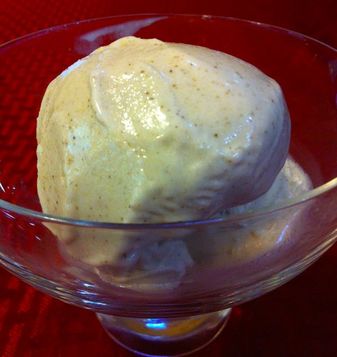 I rarely buy ice-cream any more, as it is very easy to make my own, and then I can be sure it doesn't have added oils, sugar, carrageenan, or anything else I might wish to avoid. Not only that but a pint of cashew Ice cream from the store, typically costs about 5 dollars. You can make a pint of this maple-vanilla cashew ice-cream for just a dollar or two! Although this doesn't take much time to make, you must plan ahead, as it does need some time to freeze. I do not own an ice-cream maker --but I assume you could just pop this recipe into one if you own one...but I make this using my Vitamix. You could probably mix the ingredients up using a less powerful blender and just blending for a longer time, but once you have frozen the mixture into an ice-cube tray, I imagine you would need the power of a Vitamix or other powerful blender to turn it into soft-serve. Perhaps a food processor fitted with an, "S" blade would work for this step though. 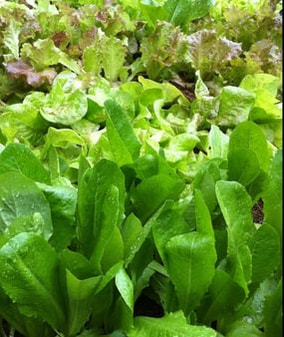 I remember clearly how I felt the day I learned that I might be at risk of exposure to Mad Cow Disease from buying and eating locally grown organic kale from my food co-op. I'd been vegan at that point for over 20 years. One of the benefits I had counted on for myself and my family from our choice to be vegan, was the fact that by not eating meat or dairy, we were not being exposed to the prions that cause Mad Cow Disease. But that was before I signed up for a gardening class taught by local organic farmers. Imagine my surprise when I heard them describe how they sprayed dried animal blood, bone-meal and fish emulsion right onto the leaves of their organicly grown greens. This they said, was a superb way to quickly, "feed" the plants nutrients which they would absorb directly through their leaves. I felt sick. It had never occurred to me that by supporting local organic farmers and buying their garden 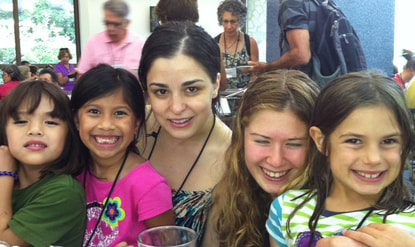 In 1942 President FDR – husband to social justice hero Eleanor Roosevelt, signed an executive order that put thousands of law-abiding Japanese American citizens in prison camps. There was little outcry. In the 1970s, in collaboration with doctors, our government forced African American men to endure late stage syphilis. Few with knowledge of this objected. U.S. history begins with violently removing indigenous inhabitants from their ancestral lands. Shockingly, in the 1800s, some abolitionists opposed women voting. Today some who support civil rights for people of color oppose marriage equality for LGBTQ identifying individuals. The book, The Immortal Life of Henrietta Lacks, describes a large American hospital in the 1950s injecting cancer cells into hundreds of patients without their knowledge or consent. Three Jewish doctors were the only ones to object. But their views were marginalized as being “overly sensitive because of the Holocaust." History is full of similar examples. Perhaps that is why Albert Einstein said, “The world is a dangerous place not because of those who do evil, but because of those who look on and do nothing.” The Holocaust is one of the most egregious examples of human’s capacity to look away and disregard injustice. After hearing about it, many wanted to know, “How did so many seemingly average people allow it to happen? The classic experiment by Stanley Milgram sought to answer this. His data showed that under certain conditions, half of us will go along with things we know harm others. Milgram stated, "Ordinary people, simply doing their jobs, and without any particular hostility on their part, can become agents in a terrible destructive process." Some cultures (and by implication their cultural practices) appear to be less vulnerable to this. So it’s worth asking, what practices might make us less likely to ignore injustice threatening someone else?  I learned about Phenylketonuria in my prenatal class, when I was pregnant. PKU is a genetic disease in which the gene that codes for a certain protein (an enzyme) that enables one to break down the amino acid, phenylalanine is defective. As a result, this amino acid accumulates and becomes toxic to the brain. Left untreated it can quickly result in severe and permanent mental disability. Although the incidence of PKU is only one in ten thousand births, all fifty states have laws requiring newborns to be tested for this genetic disease. That is because the effects of untreated PKU are devastating but completely preventable with treatment. Detection is simple -- they prick the heal of the newborn, and get a small blood sample. If the blood has high levels of phenylalanine this is considered positive for PKU. The treatment then is a strict, low protein diet for the rest of one's life. Unfortunately the timing of when this test is done most of the time, increases the risk of a false negative -- meaning there is the possibility of NOT identifying a baby with PKU. Babies born to vegan mothers may even be at INCREASED risk of being falsely told their baby does not have PKU, because the vegan diet... Margaret Kramar just shared with me a letter that she sent to Paul Wesslund of Kansas Country Living Magazine. As I doubted that the magazine will print Margaret's excellent letter, I wanted to do my part to amplify her important sentiments. So here it is:
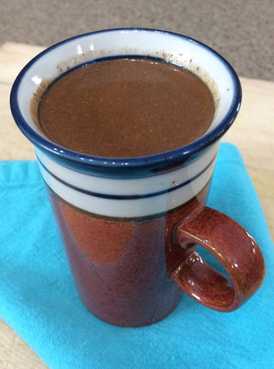 Looking for a warm, sweet, rich comforting beverage to enjoy that won't ruin your healthy diet? This hot carob-almond drink is a recipe that I created when my children were young. I was looking for an alternative to hot chocolate, that would be free of caffeine, and saturated fat, and not have too many added sugars. Because this recipe uses carob, which is naturally sweet instead of bitter like cocoa, only 1 TBS of maple syrup and 20 drops of stevia extract are sufficient to sweeten two generous mugs. The combination of chia seeds and guar gum, makes this rich and thick without loading up on calories, fat nor processed starches. An added bonus -- carob is less expensive to buy than cocoa -- ESPECIALLY cocoa that is free of the tarnish of child slave labor. 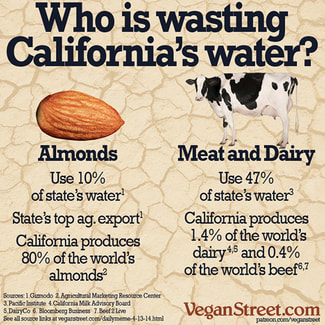 It takes about a gallon of water to grow a single almond. That does seem like a lot. Especially when compared to the water it takes to grow peas, sweet potatoes, or broccoli. But virtually everyone that I have ever seen make a big deal about the water footprint in almonds are people who consume meat, dairy and eggs. Why does that matter? Well take a look  My daughter Sarina Farb wrote this guest post while still a student at Grinnell College. She has since graduated with degrees in biochemistry and policy studies and plans to begin blogging at: BornVegan.Org ------------------------------------------------------ Recently, an Italian bill proposed jail time for parents irresponsibly imposing a vegan diet on their children. It has created a lot of buzz and discussion over whether vegan parents should be allowed to “force their values” on their children. A common theme in articles and commentary I have read is that regardless of a parent’s values, they shouldn’t “force” their radical choices on their children, 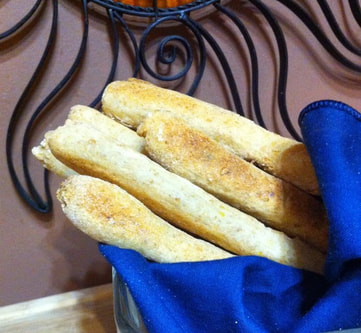 I dedicate this recipe to my friend Marcy. When I brought my potato rolls to a gathering and she didn't try them because she was avoiding nightshades -- that family of plants that includes tomatoes, potatoes, peppers, and eggplant, she asked me, "Do you suppose this recipe would work if you substituted sweet potatoes?" Her question prompted me to experiment, and my family has been thrilled with the results. I like these even better than my potato rolls! I make these without any salt, since learning more about how salt increases our risk of osteoporosis, high blood pressure, and autoimmune disease. But if a no-salt bread stick would 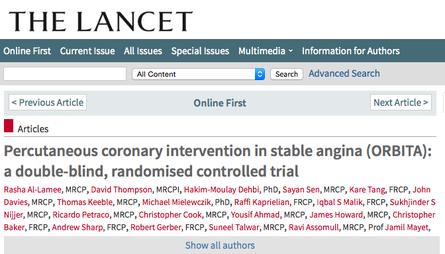
A new study, just published in the Lancet gives us more evidence for #4. This Nov 2, 2017 study examined a procedure, inserting stents to relieve stable angina, that has been a standard of care for coronary patients, and found little benefit. Stents are widely done, very expensive, and can have negative consequences that patients aren't made aware of. For Vitamin A Deficiency -- Mowing Down Vegans?  I did it again. As I have been known to do on occasion, I went over to the dark side. That is I followed some links that led me to that part of the blogosphere, that thinks being vegan is not safe, and that the only people who are vegan long term, must be cheating, otherwise they would die. This time my journey started because I just had to know for myself if those discussing a particular issue on-line (and I have now completely forgotten what it was) were cherry picking studies or taking lines from research papers out of context to shore up their perspective -- the plant-based proponents or the die-hard omnivores, so down the rabbit hole I went. Although I certainly don't have time to deeply pursue every point-of-disagreement between bloggers with differing nutritional perspectives, sometimes when the disagreement is over specific, "facts." I just have to know for myself, who is really misrepresenting the science. It was a recent such foray that led me to yet another alarmist post declaring that vegan diets are dangerously deficient in many Gluten-Free, Sugar-Free, Oil-Free Cranberry Muffin Recipe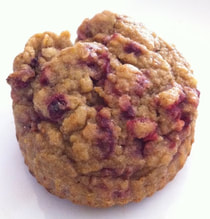 Walking through the produce isle recently I saw my first bag of fresh cranberries for this season, and it got me to reworking an old favorite recipe of mine -- cranberry muffins. These are a crowd pleaser and fairly simple to make. There is no added salt in these, but as you probably know, both baking powder and baking soda do contain significant amounts of sodium. When I make these for people on low-sodium diets, I have been omitting the baking soda -- (and using just the two teaspoons of baking powder) This makes them a bit denser, but still really good. This is a great recipe to use up apples that have gotten soft or a bit past their prime -- you could also substitute apple sauce for the blended apples. This recipe makes 24 muffins. Ingredients: 3 cups sorghum flour 2 tsp guar gum (or xanthan gum) 1/2 cup ground golden flax seed 1/3 cup arrowroot powder 2 tsp Rumford Baking Powder (Rumford does not contain aluminum) 2 tsp baking soda (omit to reduce sodium) 1 1/2 cups blended apples (about 3-4) 1 cup loosely packed fresh stevia leaves OR 1/2 tsp of stevia extract 1 cup of chopped pitted dates tightly packed 1 TBS vanilla extract 1 tsp orange extract 1 bag of fresh cranberries (about 3 cups) 1 cup of water Directions: 1) Preheat oven to 350 degrees and line two trays of muffin cups with parchment paper liners. 2) Measure out the first 6 dry ingredients into a large bowl and mix well with a wire whisk. 3) wash and slice 3-4 apples. Place slices into powerful blender and pulse until they look like apple sauce -- adding more slices until you have about 1 1/2 cups. 4) Add the stevia to the blended apples and blend until well incorporated. 5) Roughly chop the dates on a cutting board and press the pieces into a measuring cup tightly until you have 1 cup. Add these to the blender and blend on high. 6) Add the extracts and bananas and blend well one last time. 7) Place the fresh cranberries into a bowl and pick over them to remove any that are soft, then rinse the remaining with water and drain through a strainer -- repeat this a few times. 8) Pour the blender mixture into the bowl of flour and mix with a spatula to just barely incorporate, DO NOT OVER MIX. Scrape out as much as you can from the blender with the spatual and then pour the 1 cup of water into the dirty blender and blend on high to get remaining mixture into the water. Then add the washed drained cranberries to this water and pulse very carefully a few times -- just to break up the cranberries a little bit, but don't over blend -- you want some nice chunks of berry. 9) Pour the cranberries and liquid into the batter and mix well enough that no dry flour is evident, but don't over mix, then quickly spoon the mixture into 24 muffin cups dividing it evenly between all the cups -- they will be nearly full. Place into preheated oven and bake for 40-45 minutes just until the tops start to brown. Remove from oven and remove muffins from tray to cool. Due to the high fruit content, once cooled, these should be stored covered in the refrigerator, where they will keep well for at least a week. We always slice them in half horizontally and reheat them in the toaster oven before eating them -- they are much better that way. 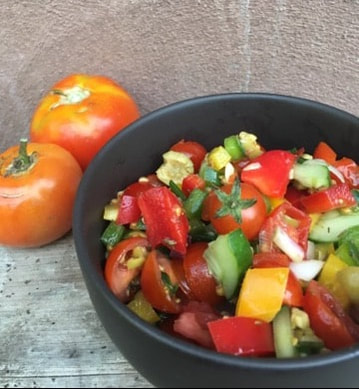 My family waits all year long -- filled with anticipation for that part of the gardening season when there is an abundance of fresh ripe home-grown tomatoes and cucumbers just so that we can make Israeli Salad. The combination of these fruits with green olives, onions, sweet peppers, lemon juice and herbs is quite extraordinary -- you just can't imagine how good this is until you taste it. No matter how large of a bowl of this I make, my family continues to have seconds, thirds and more until every last bit is gone. Normally I do not measure any of the ingredients -- so don't feel that you need to either -- just make the cucumbers and the tomatoes the major ingredients, and don't overdo the onions. Taste it frequently as you mix in the herbs, lemon juice and olives to get the taste just the way you like it. But here are some measurements -- just in case you'd like to follow a recipe. Ingredients:
3 cups fresh chopped tomatoes (large or cherry tomatoes work fine.) 3 cups cut up fresh cucumber (slice into circles and then quarter each circle) 1 cup diced red or yellow sweet peppers 1/2 cup very finely diced red onion 1 bunch of scallions chopped fine (green and white parts) 1/4 cup lemon juice 1 TBS onion powder 1/2 tsp dried thyme 1 8 oz jar of green olives Directions: 1) Place the tomatoes, cucumbers peppers, onions, and scallions into a large bowl and mix well. Drizzle with the lemon juice, sprinkle with onion powder and thyme and mix well with a large spoon. 2) Place the jar of olives into a blender -- with all the liquid too and pulse it just a few times to barely chop them up. Alternatively, you could pour the olives through a strainer -- saving the liquid and then place the olives on a cutting board and chop them with a knife. 2) Add all of the olives and the juice that they were in to the bowl and mix well. Mix again right before serving. |
Categories
All
My Best Articles are HERE
|

